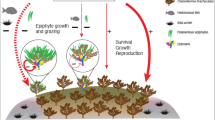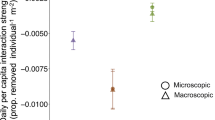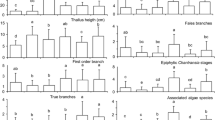Abstract
In this study of a rocky intertidal habitat in northern Japan, feeding by avian consumers had significant effects on algal assemblages and small herbivorous invertebrates. The effects of the birds on algae were different from those of invertebrate grazers such as urchins and gastropods. The abundance of the dominant algal species decreased during the grazing period, increased again after the grazing period, and indirectly affected algal species richness and evenness. Avian grazing also decreased the density of tube-dwelling amphipods on the dominant alga, but did not change the density of mobile and free-living isopods. These results suggest that avian grazers may act as habitat modifiers rather than exploitative competitors for the small herbivorous crustaceans. Avian herbivores consumed only the upper parts of large algal fronds, apparently reducing the amount of suitable microhabitat for the small herbivorous crustaceans, which are subject to a variety of physical or biological stress. Thus, avian herbivores function as ecosystem engineers, regulating community structure in a manner different to invertebrate herbivores in rocky intertidal habitats.




Similar content being viewed by others
References
Abele LG (1976) Comparative species richness in fluctuating and constant environments; coral-associated decapod crustaceans. Science 192:461–463
Baird D, Evans PR, Milne H, Pienkowski MW (1985) Utilization by shorebirds of benthic invertebrate production in intertidal areas. Oceanogr Mar Biol Annu Rev 23:573–597
Baldwin JR, Lovvorn JR (1994) Expansion of seagrass habitat by the exotic Zostera japonica, and its use by dabbling ducks and brant in Boundary Bay, British Columbia. Mar Ecol Prog Ser 103:119–127
Bertness MD, Leonard GH (1997) The role of positive interactions in communities: lessons from intertidal habitats. Ecology 78:1976–1989
Bertness MD, Leonard GH, Levine JM, Schmidt PR, Ingraham AO (1999) Testing the relative contribution of positive and negative interactions in rocky intertidal communities. Ecology 80:2711–2726
Branch GM (1981) The biology of limpets: physical factors, energy flow and ecological interactions. Oceanogr Mar Biol Annu Rev 19:235–379
Branch GM (1984) Competition between marine organisms: ecological and evolutionary implications. Oceanogr Mar Biol Annu Rev 22:429–593
Brown AC, McLachlan A (1990) Ecology of sandy shores. Elsevier, Amsterdam
Bruno JF, Bertness MD (2001) Habitat modification and facilitation in benthic marine communities. In: Bertness MD, Gaines SD, Hay ME (eds) Marine community ecology. Sinauer Associates, Sunderland, pp 201–218
Buschmann AH (1990) Intertidal macroalgae as refuge and food for amphipoda in central Chili. Aquat Bot 36:237–246
Castenholz RW (1961) The effect of grazing on marine littoral diatom populations. Ecology 42:783–794
Charman K (1977) The grazing of Zostera by wildfowl in Britain. Aquaculture 12:229–233
Coleman RA, Goss-Custard JD, Durell SEA le V dit, Hawkins SJ (1999) Limpet Patella spp. consumption by oystercatchers Haematopus ostraleegus: a preference for solitary prey items. Mar Ecol Prog Ser 183:253–361
Creese RG, Underwood AJ (1982) Analysis of inter- and intra-specific competition amongst intertidal limpets with different methods of feeding. Oecologia 53:337–346
Dayton PK (1971) Competition, disturbance and community organization: the provision and subsequent utilization of space in a rocky intertidal community. Ecol Monogr 41:351–389
Duffy JE, Hay ME (2000) Strong impacts of grazing amphipods on the organization of a benthic community. Ecol Monogr 70:237–263
Duggins DO, Eckman JE, Sewell AT (1990) Ecology of understory kelp environments II. Effects of kelps on recruitment on benthic invertebrates. J Exp Mar Biol Ecol 143:27–45
Farrell TM (1991) Models and mechanisms of succession: an example from a rocky intertidal community. Ecol Monogr 61:95–113
Feare CJ, Summers RW (1985) Birds as predators on rocky shores. In: Moore PG, Seed R (eds) The ecology of rocky coast. Columbia University Press, New York, pp 249–264
Frank PW (1982) Effects of winter feeding on limpets by Black Oystercatchers, Haematopus bachmani. Ecology 63:1352–1362
Good TP (1992) Experimental assessment of gull predation on the Jonah crab Cancer borealis (Stimpson) in New England rocky intertidal and shallow subtidal zones. J Exp Mar Biol Ecol 157:275–284
Hamilton DJ (2000) Direct and indirect effects of predation by common eiders and abiotic disturbance in an intertidal community. Ecol Monogr 70:21–43
Hawkins SJ, Hartnoll RG (1983) Grazing of intertidal algae by marine invertebrates. Oceanogr Mar Bio Annu Rev 21:195–282
Hixon MA, Brostoff WN (1996) Succession and herbivory: effects of differential fish grazing on Hawaiian coral-reef algae. Ecol Monogr 66:67–90
Hocky PAR, Underhill LG (1984) Diet of the African black oystercatcher Haematopus moquini on rocky shores: spatial, temporal and sex-related variation. S Afr J Zool 19:1–11
Hori M, Noda T (2001a) An unpredictable indirect effect of algal consumption by gulls on crows. Ecology 82:3251–3256
Hori M, Noda T (2001b) Spatio-temporal variation of avian foraging in the rocky intertidal food web. J Anim Ecol 70:122–137
Hori M (2003) Food web structure and dynamics attributed to avian foraging and allochthonous input in the rocky intertidal habitat. PhD thesis, Hokkaido University, Hokkaido, Japan
Iwasaki K (1993a) Synergistic effects of mixed grazing by intertidal limpets on sessile organisms: consequences of differences in grazing ability and feeding habit. Physiol Ecol Jpn 30:1–30
Iwasaki K (1993b) The roles of individual variability in limpets’ resting site fidelity and competitive ability in the organization of a rocky intertidal community. Physiol Ecol Jpn 30:31–70
Jacobs RPWN, Denhartog C, Braster BF, Carriere FC (1981) Grazing of the seagrass zostera noltii by birds at terschelling (Dutch Wadden sea). Aquat Bot 10:241–259
Jefferies RL (1988) Vegetational mosaics, plant-animal interactions and resources for plant growth. In: Gottlieb LD, Jain SK (eds) Plant evolutionary biology. Chapman & Hall, London, pp 341–369
Jones CG, Lawton JH, Shachak M (1994) Organisms as ecosystem engineers. Oikos 69:373–386
Kent AC, Day RW (1983) Population dynamics of an infaunal polychaete: the effect of predators and adult-recruit interaction. J Exp Mar Biol Ecol 73:185–203
Lassig BR (1977) Communication and coexistence in a coral community. Mar Biol 42:85–92
Lobban CS, Harrison PJ (1994) Seaweed ecology and physiology. Cambridge University Press, Cambridge
Lubchenco J (1978) Plant species diversity in a marine intertidal community: importance of herbivore food preference and algal competitive abilities. Am Nat 112:23–39
Lubchenco J, Gaines SD (1981) A unified approach to marine plant-herbivore interactions. 1. Populations and communities. Annu Rev Ecol Sys 12:405–437
Marsh CP (1986) Rocky intertidal community organization; the impact of avian predators on mussel recruitment. Ecology 67:771–786
Menge BA (1995) Indirect effects in marine rocky intertidal interaction webs: patterns and importance. Ecol Monogr 65:21–74
Menge BA, Sutherland JP (1987) Community regulation, variation in disturbance, competition and predation in relation to environmental stress and recruitment. Am Nat 130:730–757
Mukai H (1971) The phytal animals on the thalli of sargassum in the sargassum region, with reference to their seasonal fluctuations. Mar Biol 8:170–182
Odling-Smee SE, Laland KN, Feldman MW (2003) Niche construction: the neglected process in Evolution. Princeton University Press, Princeton
Paine RT, Vadas RL (1969) The effects of grazing by sea urchins Strongylocentrotus spp. on benthic algal populations. Limnol Oceanogr 14:710–719
Peterson CH, Summerson HC, Duncan PB (1984) The influence of seagrass cover on population structure and individual growth of a suspension-feeding bivalve, Mercenaria mercenaria. J Mar Res 42:123–138
Peterson CH, Grabowski JH, Powers SP (2003) Estimated enhancement of fish production resulting from restoring oyster reef habitat: quantitative valuation. Mar Ecol Prog Ser 264:249–264
Petraitis PS (1990) Direct and indirect effects of predation, herbivory, and surface rugosity on mussel recruitment. Oecologia 83:405–413
Pohle DG, Bricevj VM, GarciaeSquivel Z (1991) The eelgrass canopy—an above-bottom refuge from benthic predators from juvenile bay scallop Agropecten irradians. Mar Ecol Prog Ser 74:47–59
Portig AA, Mathers RG, Mkontgomery WI, Govier RN (1994) The distribution and utilization of Zostera species in Strangford Lough, Northern Ireland. Aquat Bot 47:317–328
Raffaelli DG, Hall SJ (1992) Compartments and predation in an estuarine food web. J Anim Ecol 61:551–560
Raffaelli DG, Hall SJ (1996) Assessing the relative importance of trophic links in food webs. In: Polis GA, Winemiller KO (eds) Food webs: integration of patterns and dynamics. Chapman & Hall, New York, pp 185–191
Raffaelli DG, Milne H (1987) An experimental investigation of the effects of shorebird and flatfish predation on estuarine invertebrates. Est Coast Shelf Sci 24:1–13
Reise K (1985) Tidal flat ecology: an experimental approach to species interactions. Springer, Berlin Heidelberg New York
Ricklefs RE, Miller GL (1999) Ecology, 4th edn. Freeman, New York
Seed R (1996) Patterns of biodiversity in the macro-invertebrate fauna associated with mussel patches on the rocky shores. J Mar Biol Assoc 76:203–210
Thrush SF, Pridmore RD, Hewitt JE, Cummings VJ (1994) The importance of predators on a sandflat: interplay between seasonal changes in prey densities and predator effects. Mar Ecol Prog Ser 107:211–222
Tokeshi M (1993) Species abundance patterns and community structure. Adv Ecol Res 24:111–186
Trumble JT, Kolodyn-Hirsch DM, Ting IP (1993) Plant compensation for arthropod herbivory. Annu Rev Entomol 38:93–119
Tsuchiya M, Nishihira M (1985) Islands of mytilus as a habitat for small intertidal animals-effect of island size on community structure. Mar Ecol Prog Ser 25:71–81
Underwood AJ (1986) Physical factors and biological interactions: the necessity and nature of ecological experiments. In: Moore PG, Seed R (eds) The ecology of rocky coast. Columbia University Press, New York, pp 372–390
Underwood AJ, Denley EJ, Moran MJ (1983) Experimental analyses of the structure and dynamics of mid-shore rocky intertidal communities in New South Wales. Oecologia 56:202–219
Vance RR (1978) A mutualistic interaction between a sessile marine clam and its epibionts. Ecology 59:679–685
von Ende CN (2001) Repeated-measures Analysis: growth and other time-dependent measures. In: Scheiner SM, Gurevitch J (eds) Design and analysis of ecological experiments. Oxford University Press, New York, pp 134–157
Watson DC, Norton TA (1985) Dietary preferences of the common periwinkle Littorina littorea (L). J Exp Mar Biol Ecol 88:193–211
Wootton JT (1992) Indirect effects, prey susceptibility, and habitat selection: impacts of birds on limpets and algae. Ecology 73:981–991
Wootton JT (1993a) Indirect effects and habitat use in an intertidal community: interaction chains and interaction modifications. Am Nat 141:71–89
Wootton JT (1993b) Size-dependent competition: effects on the dynamics vs. the end point of mussel bed succession. Ecology 74:195–206
Wootton JT (1995) Effects of birds on sea urchin and algae: a lower-intertidal trophic cascade. Ecoscience 2:321–328
Wootton JT (1997) Estimates and tests of per capita interaction strength: diet, abundance, and impact of intertidally foraging birds. Ecol Monogr 67:45–64
Acknowledgments
We would like to thank S. Thrush, D. Lohrer, and T. Wootton for their number of beneficial comments on the MS. We also thank S. Goshima, H. Ogi, A. S. Ilano, M. Nakaoka, and T. Miyashita for a number of helpful suggestions. T. Amano gave us some suggestions about avian foraging. This work was made possible by the generous hospitality of the fishery officers of the Hiura Fishermen’s Cooperative Association. We would also like to thank the members of the Laboratory of Marine Biodiversity of Hokkaido University for their help in the field.
Author information
Authors and Affiliations
Corresponding author
About this article
Cite this article
Hori, M., Noda, T. & Nakao, S. Effects of avian grazing on the algal community and small invertebrates in the rocky intertidal zone. Ecol Res 21, 768–775 (2006). https://doi.org/10.1007/s11284-006-0192-8
Received:
Accepted:
Published:
Issue Date:
DOI: https://doi.org/10.1007/s11284-006-0192-8




